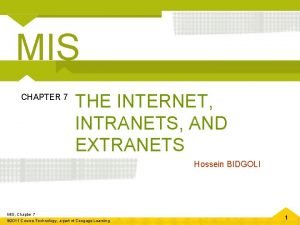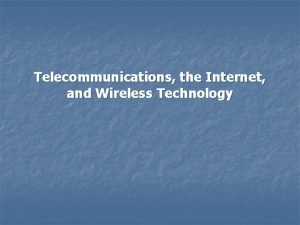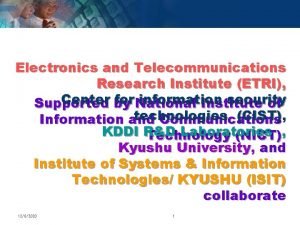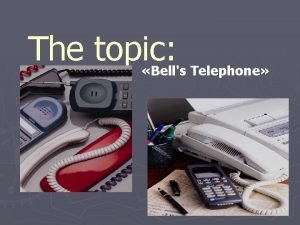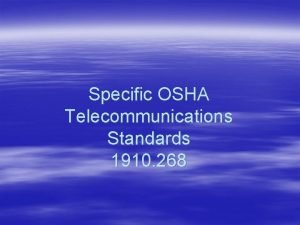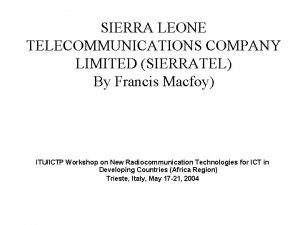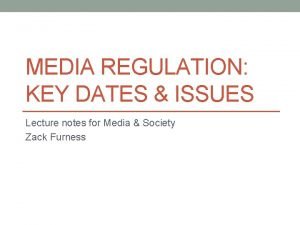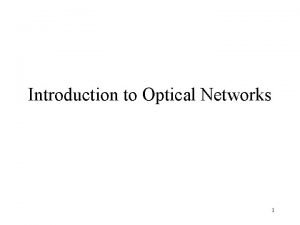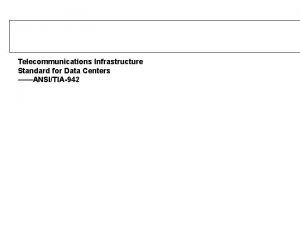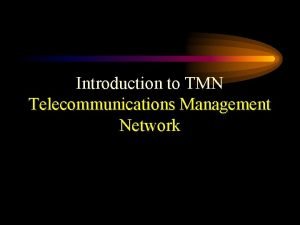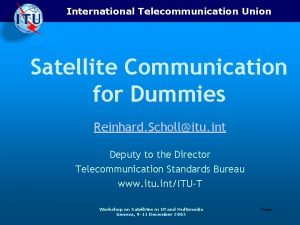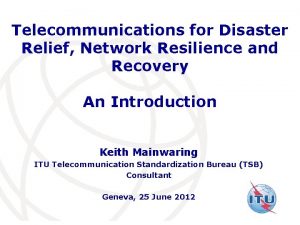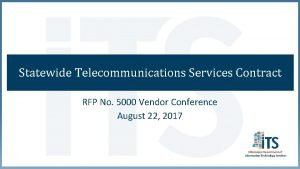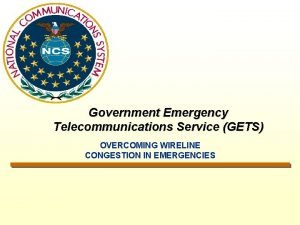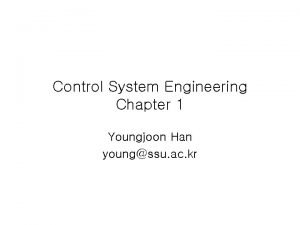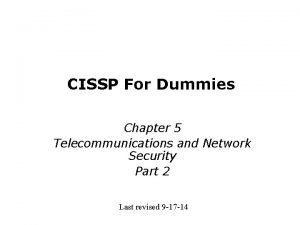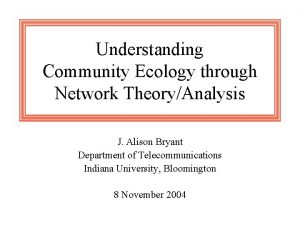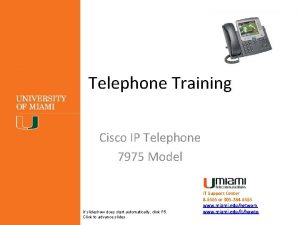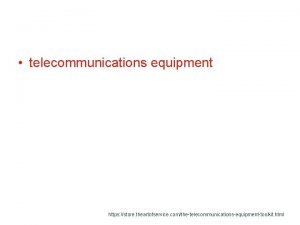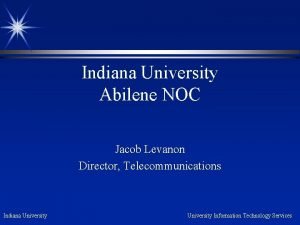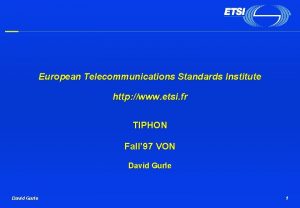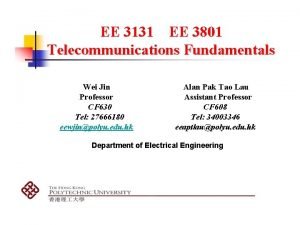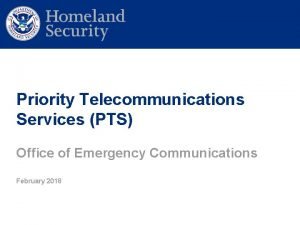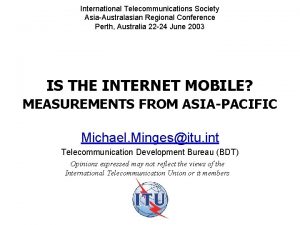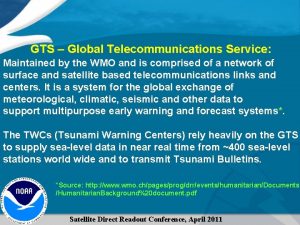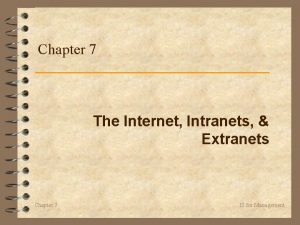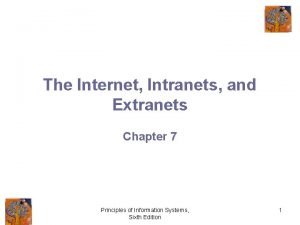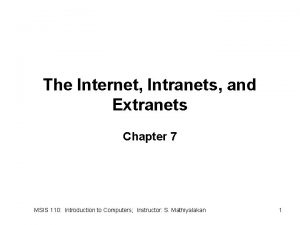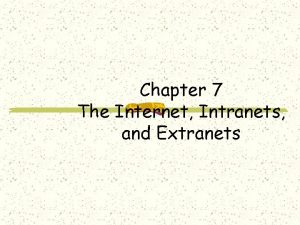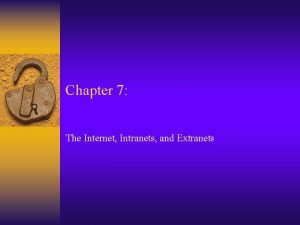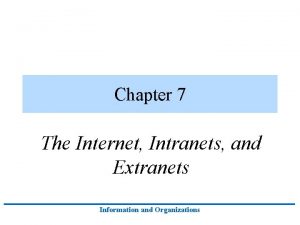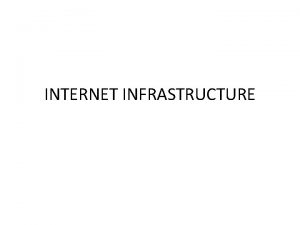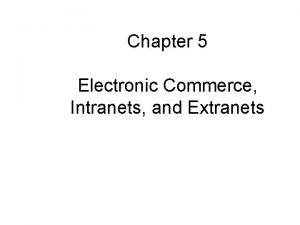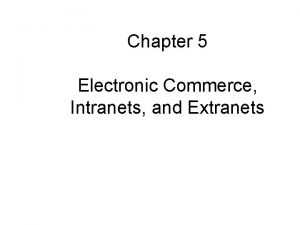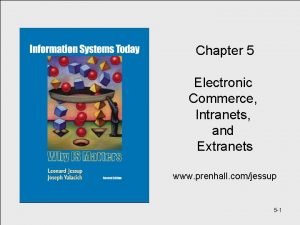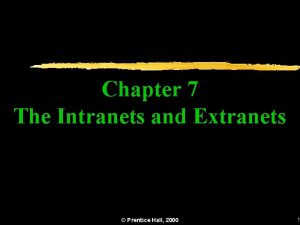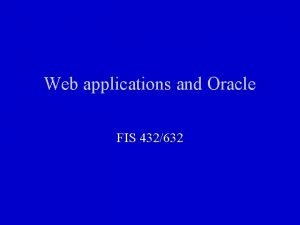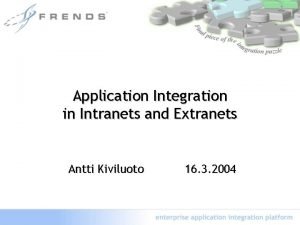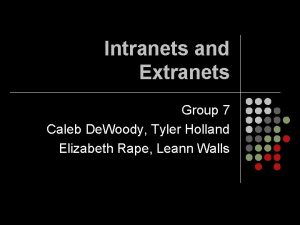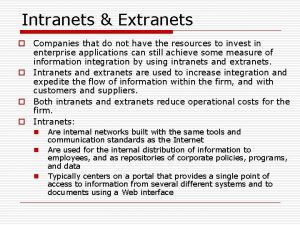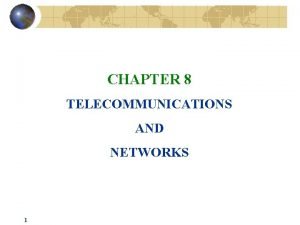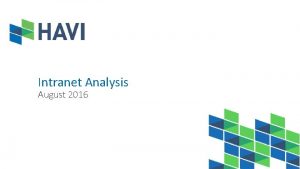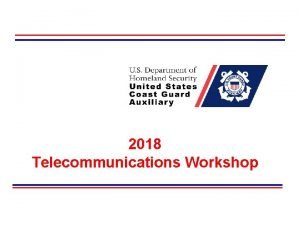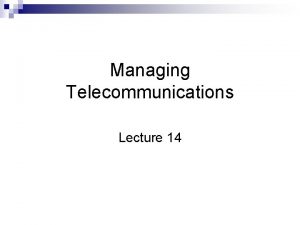Telecommunications the Internet Intranets and Extranets Chapter 4















































- Slides: 47

Telecommunications, the Internet, Intranets, and Extranets Chapter 4 Fundamentals of Information Systems, Second Edition 1

Learning Objectives – Define the term telecommunications and identify and describe the function of the components of a telecommunications system. – Identify and briefly describe three basic data processing strategies, including their advantages and disadvantages. Fundamentals of Information Systems, Second Edition 2

Learning Objectives – Briefly describe how the Internet works, including alternatives for connecting to it and the role of Internet service providers. – Identify and briefly describe common Internet services. Fundamentals of Information Systems, Second Edition 3

Learning Objectives – Describe the World Wide Web and the way it works, including the use of Web browsers, search engines, Java, and other Web tools. – Define the terms intranet and extranet and discuss how organizations are using them. – Identify several control and management issues associated with the use of networks. Fundamentals of Information Systems, Second Edition 4

Telecommunication – Electronic transmission of signals for communications – Telecommunications device is a hardware component that allows electronic communication to occur – Telecommunications medium carries an electronic signal and interfaces between a sending device and a receiving device Fundamentals of Information Systems, Second Edition 5

Elements of a Telecommunications System Fundamentals of Information Systems, Second Edition 6

Media Types (1) – Twisted-pair wire cable: Twisted pairs of copper wire • Used in telephone service • Slow transmission – Coaxial cable: Conductor wire is insulated • Faster than twisted-pair – Fiber-optic cable: Thin strands of glass bound together • Uses light beams • Faster than coaxial cable Fundamentals of Information Systems, Second Edition 7

Media Types (2) – Microwave transmission: High-frequency radio signal • Must have unobstructed line of sight between sender and receiver • Possible to intervene – Cellular transmission: Divide area into cells • Each cell has a mobile telephone subscriber unit • Possible to intervene – Infrared transmission: Signals as light waves Fundamentals of Information Systems, Second Edition 8

Common Wiring and Cabling Types Fundamentals of Information Systems, Second Edition 9

Common Telecommunications Devices – Modem: Translates data from digital form into analog form (for ordinary phones) and back • MOdulation and DEModulation – Fax modem: Facsimile device but also a modem – Multiplexer: Allow several signals to be transmitted over the same line – PBX: Manages both voice and data transfer • Switching equipment routes phone calls and messages within the building Fundamentals of Information Systems, Second Edition 10

Carriers and Services • Common carriers: Turk Telecom, AT&T • Switched lines – Use switching equipment to connect one phone to another – Switch: Special purpose circuit that directs messages in certain directions • Digital subscriber lines (DSL) – Use existing lines to transmit signals over 500 Kbps – Faster Internet access Fundamentals of Information Systems, Second Edition 11

Costs, Advantages, and Disadvantages of Several Line and Service Types Line/Service Speed Cost per month Advantages Disadvantages Standard phone line 56 Kbps $10 -40 Broadly available Too slow ISDN 64 -128 Kbps $50 -150 Faster Not available everywhere DSL 500 Kbps 1. 5 Mbps $20 -120 Use standard Expensive; not line available ew. Cable modem 500 Kbps 1. 5 Mbps $20 -120 Use existing cable T 1 1. 544 Mbps $600 -1200 FAST; used by EXPENSIVE Satellite 60 -800 Kps $30 -120 “” corporations Instead of cable or DSL Fundamentals of Information Systems, Second Edition Expensive installation 12

Networks and Distributed Processing • Computer network - communications media, devices, and software needed to connect two or more computer systems. • Centralized processing - processing occurs in a single location or facility. • Decentralized processing - processing devices are placed at various locations. • Distributed processing - computers are placed at remote locations but are connected to each other via telecommunications devices. Fundamentals of Information Systems, Second Edition 13

Terminal-to-Host Connection • Host computer has the data and the processing power • Dumb terminal contacts host computer for jobs Fundamentals of Information Systems, Second Edition 14

File Server Connection • The application and database reside in host computer. • Files transferred as a whole and processed by the user Fundamentals of Information Systems, Second Edition 15

Client/Server Connection • Servers have special functionalities (database server, program execution, etc. ) • Clients request services from servers • Clients process service results Fundamentals of Information Systems, Second Edition 16

Network Types • Local area network (LAN) – Same geographic area – Wired into office buildings (unshielded twisted-pair) • Wide area network (WAN) – Microwave and satellite transmission – Long-distance calls • International network – Transborder data flow – International laws Fundamentals of Information Systems, Second Edition 17

A Typical LAN Fundamentals of Information Systems, Second Edition 18

A Wide Area Network Fundamentals of Information Systems, Second Edition 19

Connecting Computing Devices Using a Home Network Fundamentals of Information Systems, Second Edition 20

Communications Software and Protocols • Communications software - provides a number of important functions in a network • Network operating system - controls the computer systems and devices on a network and allows them to communicate with each other • Network management software - a manager can monitor the use of individual computers and shared hardware • Communications protocol - rules and standards that make communications possible Fundamentals of Information Systems, Second Edition 21

Common Communications Protocol Description Open Systems Interconnection (OSI) Divides data communication into seven layers for maintenance Transport control protocol/Internet Protocol (TCP/IP) Primary communication protocol of the Internet Ethernet Used in LANs Asynchronous transfer mode (ATM) Organizes data into 53 -byte cells for fast transmission 802. 11 a Supports wireless ATM devices Bluetooth Wireless communication for cell phones, handheld computers 802. 11 b (Wi-fi) Fundamentals of Information Systems, Second Edition 22

Use and Functioning of the Internet Fundamentals of Information Systems, Second Edition 23

Routing Messages Over the Internet Fundamentals of Information Systems, Second Edition 24

How the Internet Works • Internet Protocol (IP): Set of rules to pass packets from one computer to another • Transport Control Protocol (TCP): Set of rules to establish and break connections • Internet Protocol Address: Unique address for each computer on the Internet • Static vs. dynamic Fundamentals of Information Systems, Second Edition 25

U. S. Top-Level Domain Affiliations Fundamentals of Information Systems, Second Edition 26

Three Ways to Access the Internet Fundamentals of Information Systems, Second Edition 27

Internet Service Providers • Organizations that provide access to the Internet • Choose based on price, reliability, other features (e-mail address) • Examples: Superonline, E-kolay Fundamentals of Information Systems, Second Edition 28

Internet and Telecommunications Services Fundamentals of Information Systems, Second Edition 29

Summary of Internet Services (1) • • E-mail Instant messaging Telnet/SSH FTP Chat rooms Internet phone Internet video conferencing Fundamentals of Information Systems, Second Edition 30

Summary of Internet Services (2) • • Shop on the Web: Auctions: http: //www. gittigidiyor. com/ Distance learning Music, radio on the Internet Fundamentals of Information Systems, Second Edition 31

Common Abbreviations Used in Personal E-Mail Fundamentals of Information Systems, Second Edition 32

Two Approaches to Electronic Data Interchange Fundamentals of Information Systems, Second Edition 33

Public Network and Specialized Services Fundamentals of Information Systems, Second Edition 34

The World Wide Web Fundamentals of Information Systems, Second Edition 35

The World Wide Web An Internet service comprising tens of thousands of independently owned computers that work together as one. – Home page: Cover page with text and graphics – Hypertext markup language (HTML): Standard language to describe Web pages Fundamentals of Information Systems, Second Edition 36

Several Interesting Web Sites Fundamentals of Information Systems, Second Edition 37

Sample HTML Fundamentals of Information Systems, Second Edition 38

Search Engine Fundamentals of Information Systems, Second Edition 39

Intranets and Extranets Fundamentals of Information Systems, Second Edition 40

Intranets and Extranets • Intranet – an internal corporate network built using Internet and WWW standards and products • Extranet - a network that links selected resources of the intranet of a company with its customers, suppliers, or other business partners • Virtual private network - a secure connection between two points across the Internet • Firewall - a device that sits between your internal network and the outside Internet Fundamentals of Information Systems, Second Edition 41

Summary of Internet, Intranet, and Extranet Users Fundamentals of Information Systems, Second Edition 42

Virtual Private Network Fundamentals of Information Systems, Second Edition 43

Net Issues Fundamentals of Information Systems, Second Edition 44

Privacy and Security • Cookie: Text that is put on user computer to track Web site usage • Cryptography: Converting a message into a secret code and then back into the message • Encryption • Digital Signature: Who sent the message, did the message change on the way? Fundamentals of Information Systems, Second Edition 45

Cryptography Fundamentals of Information Systems, Second Edition 46

Summary • Networks - used to share hardware, programs, and databases across the organization. • Internet - transmits data from one computer (called a host) to another. • The Web - a collection of tens of thousands of independently owned computers that work together as one in an Internet service. Fundamentals of Information Systems, Second Edition 47
 Mis chapter 7
Mis chapter 7 Sps intranets
Sps intranets Telecommunications, the internet, and wireless technology
Telecommunications, the internet, and wireless technology Telecommunications the internet and wireless technology
Telecommunications the internet and wireless technology Telecommunication and data communication
Telecommunication and data communication Electronics and telecommunications research institute
Electronics and telecommunications research institute Introduction of telecommunication
Introduction of telecommunication Internet or internet
Internet or internet A pioneer in the field of telecommunications
A pioneer in the field of telecommunications Telecommunications project management
Telecommunications project management Osha telecommunications standards
Osha telecommunications standards Sierra leone telecommunications company
Sierra leone telecommunications company Telecommunications act of 1996
Telecommunications act of 1996 Venture capital telecommunications
Venture capital telecommunications In a telecommunications network architecture, a protocol is
In a telecommunications network architecture, a protocol is Telecommunications infrastructure standard for data centers
Telecommunications infrastructure standard for data centers Tmn physical architecture
Tmn physical architecture Telecommunications for dummies
Telecommunications for dummies Disaster recovery telecommunications
Disaster recovery telecommunications Danswers
Danswers Government emergency telecommunications service
Government emergency telecommunications service Telecommunications engineering
Telecommunications engineering Telecommunications for dummies
Telecommunications for dummies Department of telecommunications
Department of telecommunications Department of telecommunications
Department of telecommunications French telecommunications equipment company
French telecommunications equipment company Digital telecommunications
Digital telecommunications Iu telecommunications
Iu telecommunications European telecommunications standards institute
European telecommunications standards institute Digital telecommunications
Digital telecommunications Pts
Pts International telecommunications society
International telecommunications society Wireless telecommunications industry analysis
Wireless telecommunications industry analysis Gts telecommunications
Gts telecommunications Hát kết hợp bộ gõ cơ thể
Hát kết hợp bộ gõ cơ thể Frameset trong html5
Frameset trong html5 Bổ thể
Bổ thể Tỉ lệ cơ thể trẻ em
Tỉ lệ cơ thể trẻ em Chó sói
Chó sói Tư thế worm breton là gì
Tư thế worm breton là gì Bài hát chúa yêu trần thế alleluia
Bài hát chúa yêu trần thế alleluia Môn thể thao bắt đầu bằng từ chạy
Môn thể thao bắt đầu bằng từ chạy Thế nào là hệ số cao nhất
Thế nào là hệ số cao nhất Các châu lục và đại dương trên thế giới
Các châu lục và đại dương trên thế giới Công thức tính độ biến thiên đông lượng
Công thức tính độ biến thiên đông lượng Trời xanh đây là của chúng ta thể thơ
Trời xanh đây là của chúng ta thể thơ Mật thư anh em như thể tay chân
Mật thư anh em như thể tay chân 101012 bằng
101012 bằng
